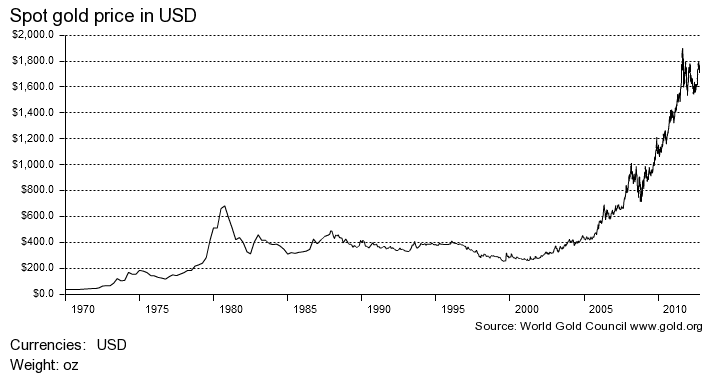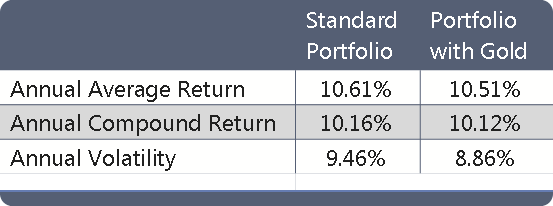From time to time we are asked by clients why we do not use a specific allocation to gold. Gold has been a store of value for nearly as long as commerce has existed, it is considered to be a hedge against inflation, and now with the creation of exchanges traded funds (ETFs) that hold gold and other precious metals, it is easy to invest in. With the unprecedented amount of monetary stimulus by the Federal Reserve over the previous four years, many investors fear that high rates of inflation are inevitable, and assets that might act as an inflation hedge are in high demand. Gold is believed to be a very safe asset that provides strong diversification benefits as it tends to be uncorrelated with most other asset classes. Finally, gold has been a particularly strong performing asset in recent years, returning over 18.5% annually in the previous decade, while large cap U.S. equities (as represented by the S&P 500) have only returned about 8% per year over the same period.
Summarizing, gold is believed to have the following characteristics:
1) It is a safe asset.
2) It diversifies a portfolio.
3) It has outperformed large U.S. stock indices over the previous decade.
4) It protects against inflation.
If all of these hold true, why is gold not a component of Empirical portfolios? To understand our approach, it is important to first cut through all the hype surrounding gold as an investment. While gold certainly does have some of the beneficial characteristics mentioned above (low correlation with other asset classes, strong recent performance), we also consider the merits of the asset itself. Unlike most equities or fixed income securities, gold does not generate a stream of income; the returns from gold are all as a result of price movement. This means that gold returns are entirely driven by the forces of supply and demand. This is not unique to gold, other commodities have similar characteristics. The thing that sets gold apart from commodities like oil, industrial metals, and agricultural products is that gold has very little value in use (relative to its price), meaning that the price of gold is mainly based on investor speculation. Only around 10% of gold demand is for use as an industrial metal, meaning the remaining demand is for gold jewelry and investment purposes, and gold demand for jewelry purposes has declined sharply as the price of gold has increased. This means that by holding gold in your portfolio, you are implicitly assuming an increase in the speculative demand for gold, which is the type of predictive investing that Empirical does not believe in. Next, we address each of the arguments for gold in turn.
1) Gold is a safe asset
Because gold has long served as a store of value, many investors view it as a safe and stable asset, with bond-like characteristics. However, the return statistics do not back this up. The following table shows the risk and return statistics of gold, along with other asset classes, since 1973 (or since inception for those assets that were not around in 1973).
The above table shows that gold is not a safe asset class, and may in fact be even riskier than assets like small cap stocks, real estates, and commodities, which are typically thought of as particularly volatile. Of all the assets included, gold had the largest drop in value, as well as the longest drawdown period, lasting over 27 years.
2) Gold diversifies a portfolio
For a different perspective, we can quantitatively investigate the effect of adding gold to a portfolio. To this end, we created two portfolios; a 60% equity and 40% fixed income portfolio (using our Targeted Premium 3 (TP3) and Targeted Credit 1 (C1) models), and another portfolio with a 55%/40%/5% split using equities, fixed income, and gold respectively.[1] The following table shows the risk and return of those portfolios using monthly return data from January 1971 to September 2012.
As the table demonstrates, the portfolio with gold had both slightly lower return and risk, though these differences among the two portfolios were not statistically significant. Another way of examining the two portfolios is to compare the return on $1, which is shown in the following graph. 
3) Gold has outperformed large U.S. stock indices over the previous decade.
Again, the effect of adding gold to the portfolio is quite small. This empirical analysis begs the question, “If adding gold reduces volatility without detracting much from returns, shouldn’t it be included in the portfolio?” Before answering this question, we consider the price of gold over the sample period. 
The preceding graph shows that gold prices are nearly at all-time highs. Much of the run-up in gold price is as a result of the Financial Crisis where panicked investors fled into assets viewed as safe (e.g., gold, treasuries, cash, etc.). It is difficult to make a case that this level of fear and uncertainty about markets will continue indefinitely, meaning gold prices will likely either return to pre-crisis levels, or at the very least not continue to increase. As discussed earlier, price appreciation is the only source of return for gold investors, so if the price does not continue to increase, holding gold will not produce positive returns.
The above portfolio analysis has not taken into account the tax treatment of gold, which is somewhat specialized. Gold, along with other precious metals, is considered a “collectable,” meaning it is taxed as ordinary income (up to 28%), instead of at the 15% capital gains rate. As long as the current tax system remains in place, this may further reduce the net returns of an investment in gold[2].
4) Gold protects against inflation.
Finally, we examine gold as an inflation hedge. It is a common belief that due to the role of gold as a store of value, that it can be used to protect against increases in nominal price levels. In fact, this is something of a misconception. Using the monthly gold data from 1971 to 2012, we find that the correlation with inflation (as measured by the consumer price index (CPI)) is .1152, or 11.52%, meaning the two series are only weakly correlated. Moreover, gold is far more volatile than the rate of inflation, with an annual standard deviation of 19.26% compared to 1.29% for the CPI (in comparison, the Empirical TP-3 equity model had an annual standard deviation of 14.66% over the same period). Treasury Inflation-Protected Securities (TIPS) have served far better as an inflation hedge, since their creation in 1997, being directly linked to the CPI.
To summarize, gold is an asset that is not priced on either its value in use or expected income stream. It does not provide significant long-term risk/return benefits as part of a portfolio even though we are in a period of unusually strong performance, and it is inefficient in terms of taxation. Finally, it does not, as is commonly believed, act as an inflation hedge. All that being said, we think having some gold exposure is not necessarily a bad thing, it just needs to be held in the proper context. For example, our Targeted Premium portfolios hold up to 5% of a commodity fund, which in turn holds around 3% of its assets in gold. Gold can have a place in a portfolio, but it should be used as a minor part of a commodity strategy, not as a separate asset class.
References:
1) DeMarco, Anthony, (2012), “15% Decline in Global Jewelry Demand.” Forbes.com, http://www.forbes.com/sites/anthonydemarco/2012/08/16/15-decline-in-global-gold-jewelry-demand/
2) N. Dempster and J. Artigas, (2010), “Gold: Inflation Hedge and Long-Term Strategic Asset.” Journal of Wealth Management, 13(2), 69-75.
3) Harris, Bryan (2012), “Is Gold Worth its Weight in a Portfolio?” Dimensional Fund Advisors.
4) Oxford Economics, (2011), “The Impact of Inflation and Deflation on the Case for Gold”, Study Commissioned by the World Gold Council.
5) Ratner, M., & Klein, S, (2008), “The Portfolio Implications of Gold Investment.” Journal of Investing, 17(1), 77-87.
[1] An Oxford Economics report commissioned by the World Gold Council suggested a 5% allocation to gold, which is why this amount was chosen for our test.
[2] It should be noted that this tax differential can be avoided by investing in Exchange Traded Notes (ETNs) which are debt securities that return the value of an index, and are thus taxed only as capital gains.



